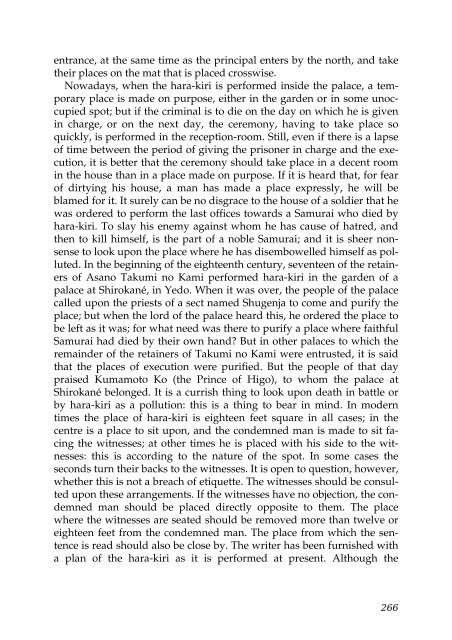You also want an ePaper? Increase the reach of your titles
YUMPU automatically turns print PDFs into web optimized ePapers that Google loves.
entrance, at the same time as the principal enters by the north, and take<br />
their places on the mat that is placed crosswise.<br />
Nowadays, when the hara-kiri is performed inside the palace, a temporary<br />
place is made on purpose, either in the garden or in some unoccupied<br />
spot; but if the criminal is to die on the day on which he is given<br />
in charge, or on the next day, the ceremony, having to take place so<br />
quickly, is performed in the reception-room. Still, even if there is a lapse<br />
<strong>of</strong> time between the period <strong>of</strong> giving the prisoner in charge and the execution,<br />
it is better that the ceremony should take place in a decent room<br />
in the house than in a place made on purpose. If it is heard that, for fear<br />
<strong>of</strong> dirtying his house, a man has made a place expressly, he will be<br />
blamed for it. <strong>It</strong> surely can be no disgrace to the house <strong>of</strong> a soldier that he<br />
was ordered to perform the last <strong>of</strong>fices towards a Samurai who died by<br />
hara-kiri. To slay his enemy against whom he has cause <strong>of</strong> hatred, and<br />
then to kill himself, is the part <strong>of</strong> a noble Samurai; and it is sheer nonsense<br />
to look upon the place where he has disembowelled himself as polluted.<br />
In the beginning <strong>of</strong> the eighteenth century, seventeen <strong>of</strong> the retainers<br />
<strong>of</strong> Asano Takumi no Kami performed hara-kiri in the garden <strong>of</strong> a<br />
palace at Shirokané, in Yedo. When it was over, the people <strong>of</strong> the palace<br />
called upon the priests <strong>of</strong> a sect named Shugenja to come and purify the<br />
place; but when the lord <strong>of</strong> the palace heard this, he ordered the place to<br />
be left as it was; for what need was there to purify a place where faithful<br />
Samurai had died by their own hand? But in other palaces to which the<br />
remainder <strong>of</strong> the retainers <strong>of</strong> Takumi no Kami were entrusted, it is said<br />
that the places <strong>of</strong> execution were purified. But the people <strong>of</strong> that day<br />
praised Kumamoto Ko (the Prince <strong>of</strong> Higo), to whom the palace at<br />
Shirokané belonged. <strong>It</strong> is a currish thing to look upon death in battle or<br />
by hara-kiri as a pollution: this is a thing to bear in mind. In modern<br />
times the place <strong>of</strong> hara-kiri is eighteen feet square in all cases; in the<br />
centre is a place to sit upon, and the condemned man is made to sit facing<br />
the witnesses; at other times he is placed with his side to the witnesses:<br />
this is according to the nature <strong>of</strong> the spot. In some cases the<br />
seconds turn their backs to the witnesses. <strong>It</strong> is open to question, however,<br />
whether this is not a breach <strong>of</strong> etiquette. The witnesses should be consulted<br />
upon these arrangements. If the witnesses have no objection, the condemned<br />
man should be placed directly opposite to them. The place<br />
where the witnesses are seated should be removed more than twelve or<br />
eighteen feet from the condemned man. The place from which the sentence<br />
is read should also be close by. The writer has been furnished with<br />
a plan <strong>of</strong> the hara-kiri as it is performed at present. Although the<br />
266



